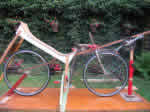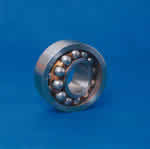LIQFITS: Pre-production
The front of the seat and the cranckset are attached to a wooden door. The front wheel fork is fixed at the right angle using a 'Workmate'. The slat that rests on the chainwheels, is to check if the straight chain-line is maintained at all time through all possible chain-positions. The seat is made of a piece of hardboard, nailed onto 2 pieces of mdf-plate that have been sawed into the right shape. On top of this I put a gardenchairchusion functioning as a surrogate Ventisit seat pad. I did some tests, to see if I could stretch my legs and if it was still comfortable to ride for a few hours. Ofcourse I also wanted to know if the seatdesign was just right for my size. After a few small corrections of the seat-angle, the distance to the crancks, and other things, the bike was the right size. Next thing I did was searching for the center of gravity; assuming that this is at the lowest point of the seat and right between the two wheels. This is why I constructed the rear-wheel bracing system in such a way that I could easily adjust the distance to the rest of the bike. The rearside of the seat can rotate around some bolts so that changing the seat-angle is a breeze.
I also simulated the under-seat-steering. It quickly showed that the Sram 7.0 halfpipe turn-shifters didn't work so well with the Shimano deore brake-levers. Because of the width of the turn-shifters, the brake-levers pretty much ended up in the middle of the under-seat steer and became close to impossible to use. So I returned the turn-shifters - and the derailleur that came with them - to the shop. Instead I bought the Deore shifters.
At the same time the decision was made to keep the under-seat-system simple and not to weld it to the frame, yet. Instead it was bolted on to a plate, so it could be moved if necessary. With this testing-steer, that rotated around a bolt in a teflon-tube and between teflon-disks, I drove for nearly 2,000 km or 1,200 miles. The final version of the steer had the bold and the teflon removed and replaced with two bearings ( 1 ball bearing and 1 conical ball bearing).

